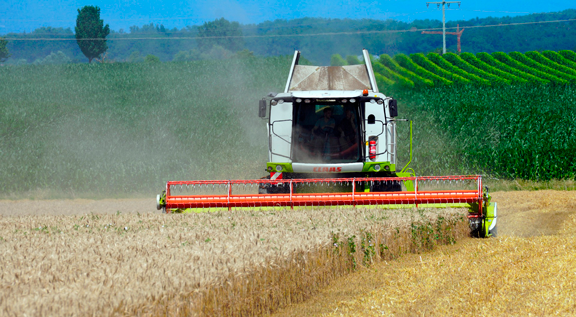
Image: Pixabay
With growth exceeding 10 million tons compared to the previous cycle, grain production should reach 265.7 million tons, as shown in the 6th Survey of the 2021/22 Harvest carried out by the National Supply Company (Conab). Published this Thursday (10), the document also shows an increase of 4.3% in the area to be planted, estimated at 72.7 million hectares – which corresponds to the incorporation of 3 million hectares, influenced, above all, by the growth in soybean and corn area.
Despite the expectation of an increase in harvest when compared to the result obtained in the 2020/21 period, there is a slight loss in production of 0.9% compared to the volume published last month, when 268.2 million tons were expected. The drop is a reflection of the strong drought seen, especially in the states in the southern region of the country and in the center-south of Mato Grosso do Sul. The adverse climate had a significant impact on the productivity of soybean and corn 1st harvest crops, mainly.
With soybean planting completed on 40.7 million hectares, an increase of 3.8% in the planted area in relation to the 2021/22 harvest, attention turns to the progress of the oilseed harvest, which already exceeds 50% across the country. As observed by the Company's technicians, the yields obtained reflect the climatic scenario during the crop cycle. Production is expected to reach 122.76 million tons.
The advance of the soybean harvest dictates the pace of second-crop corn planting. Currently, Conab estimates 74.8% of the area already sown. Highlight for Mato Grosso with 94% planted. The forecast is for planting in an area of approximately 16 million hectares, which represents an increase of 6.7% over the previous harvest. Conab's current expectation is that total cereal production will grow by 29%, reaching 112.3 million tons. The increase is driven by the better performance mainly of the second harvest of the grain, which tends to increase from 60.7 million tons in the 2020/21 period to 86.2 million tons in the current season.
{module Form RD}
Expected growth also for cotton. In the Company's current survey, an increase of 19.71 TP3T in fiber production is expected, reaching approximately 6.9 million tons, of which 2.82 million tons will come from lint alone. For beans, the first cycle of this crop was partially compromised by yield losses mainly due to the climatic adversities recorded. The legume's second harvest crops are being implemented or in full development, with the prospect of achieving a good result, guaranteeing supply to the consumer market and balancing the grain supply. In the case of rice, Conab predicts a reduction in both the cultivated area and productivity. Therefore, the estimated production is 10.3 million, a drop of 12.1% compared to the 2020/21 harvest.
Minister Tereza Cristina (Agriculture, Livestock and Supply) participated in the data announcement and highlighted the investment in technology and human capital to improve the processing and qualification of data. “Conab’s work is essential for the country, without data and information, decisions are made without precision. All Brazilian farmers, the entire sector benefit”, he highlighted.
Production costs
During the 6th survey webinar, Conab presented the percentage of fertilizer participation in costs for soybean, corn and wheat crops. According to the study, currently the participation of these products is within a range between 30% and 40% in variable costs, depending on the producing region and the product analyzed. “It is worth highlighting, however, that this percentage includes the values practiced until February of this year. The conflict between Russia and Ukraine, in turn, began at the end of last month. As a result, the impact, both on the prices received by producers and on the amounts paid for inputs, will be better measured based on the calculations to be carried out throughout this month”, ponders Conab's Production Costs Manager, Rodrigo Souza.
In the case of wheat, fertilizers represent around 33% of variable costs in Passo Fundo, in Rio Grande do Sul, while in the Paraná municipality of Cascavel the percentage reaches 38%. For 2nd harvest corn, the weight of these inputs reaches 33% in Sorriso (MT). In soybean cultivation in the municipality of Mato Grosso, the percentage of fertilizer participation reaches an index of 37%.
“Any increase in fertilizer prices has a significant impact on costs for producers, which tends to influence the prices of final products made available to consumers”, reinforces Rodrigo Souza. “Even with this increase in grain sales values, the gross and net margins for farmers follow a downward trend, given the difficulty of transferring between production and retail.”
According to data from the Foreign Trade Secretariat, around 22% of fertilizers imported last year came from Russia, followed by China with 15% and Canada with 10%.
This Friday (11), the Federal Government will launch the National Fertilizer Plan (PNF), which will be a reference for planning the fertilizer sector in the coming decades, promoting the development of national agribusiness, focusing on the main links in the chain : traditional industry, rural producers, emerging chains, new technologies, use of mineral inputs, innovation and environmental sustainability. The plan is also an important tool to reduce Brazil's dependence on imported fertilizers.
Starting in April, researchers and technicians from the Brazilian Agricultural Research Corporation (Embrapa) will begin the FertBrasil Caravan, when they will visit around 30 production centers in nine agricultural macro-regions in Brazil, with the aim of promoting increased efficiency in the use of fertilizers and inputs in the field, reduce production costs for rural producers and encourage the adoption of new technologies and good soil, water and plant management practices.
Market
In this survey, in relation to the foreign market, Conab maintained the estimate of cotton exports with a growth of 2.5%, compared to last year, expecting a volume of 2.05 million tons to be reached. For soybeans, corn and beans, the forecast for volumes to be exported remained stable at 80 million tons, 35 million tons and 200 thousand tons, respectively.
In the case of wheat, shipments remain above the historical average, with more than 800 thousand tons of the product being sold in February, according to data from the Foreign Trade Secretariat. Given this, there was a new increase in estimates for exports for the 2021 harvest, whose commercial year runs until July this year. The new forecast is that 2.1 million tons will be shipped at the end of this period. Finally, the expectation for rice sales to the foreign market was reduced, from 1.4 million tons to 1.3 million tons, given the decrease in production estimates and considering the international grain market scenario.
As for the expected final stocks, for corn the changes were not significant, with the carryover stock expected for the 2021/22 harvest at 10.3 million tons, an increase of 32.15% in relation to the previous period. For soybeans, stocks at the end of December 2022 are expected to be 2.41 million tons, a reduction of 9.1% compared to the February survey. The drop is explained by the new reduction in the production estimate for the year 2022.
As for wheat, in this survey, despite the increase in the export forecast from 1.9 million tons to 2.1 million tons, carryover stocks close the 2021 harvest at 180 thousand tons, a stable volume in relation to the February survey . The greater volume exported tends to be compensated by the increase in imports from 6.8 million tons to 7 million tons.
MAP*
By: Aline Merladete | agrolink












